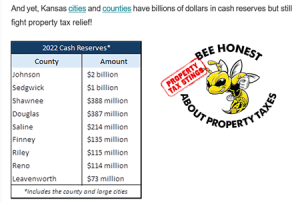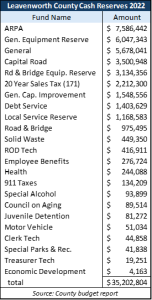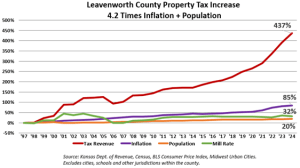It’s always amusing to hear an elected official proclaim full support of transparency and then become indignant when transparency exposes things that run counter to their narrative.
That’s what happened at the Leavenworth County Commission meeting on April 9. Commissioner Jeff Culbertson said he received calls from constituents about one of our marketing campaigns that said local governments had more than $5 billion in cash reserves in 2022, of which about $73 million is held by Leavenworth County and some cities in the county.
 Culbertson launched a multitude of false accusations at Kansas Policy Institute. He said we “hadn’t looked at their budgets and probably don’t know what our budget is.” Culbertson also said the cash reserve balances we report “come from some kind of formula” and just made an assumption about cash balances. He even said KPI’s goal is “to destroy city and county government.”
Culbertson launched a multitude of false accusations at Kansas Policy Institute. He said we “hadn’t looked at their budgets and probably don’t know what our budget is.” Culbertson also said the cash reserve balances we report “come from some kind of formula” and just made an assumption about cash balances. He even said KPI’s goal is “to destroy city and county government.”
No, Commissioner, our goal is educating taxpayers and legislators on the facts, and everything we published is accurate.
First of all, the 2022 beginning cash reserve balances come from budget reports of the 35 largest counties and 25 of the largest cities. There is no ‘formula’ involved; we simply report what is shown on each entity’s budget.
Leavenworth County began 2022 with a little over $35 million in reserves, and the City of Leavenworth (the only one included in the study from Leavenworth County) had nearly $38 million. Every entity needs some reserves, and some money is set aside to repay debt. Still, many cities and counties hold more than is necessary, and they could spend some of their reserves rather than raise property taxes.
 Leavenworth County had a $6 million General Equipment Reserve, $5.7 million in the General Fund, $3.5 million in Capital Road, and $3.1 million in Road & Bridge Equipment Reserve. The county also had $7.6 million in unspent COVID relief funds.
Leavenworth County had a $6 million General Equipment Reserve, $5.7 million in the General Fund, $3.5 million in Capital Road, and $3.1 million in Road & Bridge Equipment Reserve. The county also had $7.6 million in unspent COVID relief funds.
County Manager Mark Loughry speculated that the cash balances we reported included tax money collected on behalf of cities and school districts that hadn’t been distributed, but that is also not true, as shown in the adjacent table. Each balance comes from a fund with associated expenditures, like the General Fund, Employee Benefits, Solid Waste, etc. Anyone who looked at the county budget, as one might expect Loughry to do, would know his statement is false.
Laughry also falsely said county expenditures have “tracked close to the rate of inflation.” Assuming inflation to be around 3% this year, the Midwest City consumer price index will have increased by 29% since 2014. Leavenworth County’s 2025 budget, however, is 76% higher than 2014’s actual expenditures, and property taxes will have jumped by 98%.

By the way, Commission Chair Mike Smith actually said the county tries to keep reserves low “so we can give relief to the property tax.” You can’t make this stuff up.
Since 1997, Leavenworth County Commissioners imposed a 437% property tax increase, which is more than four times the combined change in inflation and population.

Our marketing campaign promoting the Truth in Taxation / revenue-neutral legislation was built around the theme of “Bee Honest” (because property tax stings) to reflect taxpayer sentiment toward many local officials. The shenanigans at the Leavenworth County Commission meeting this week reinforce the basis.





